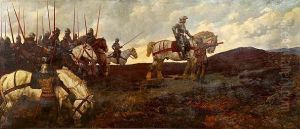Clive Macdonnell Dixon Paintings
Clive Macdonnell Dixon was a British artist born in 1881, known for his contributions to the world of painting, particularly within the realms of landscape and marine subjects. His work, characterized by its delicate handling of light and color, captures the essence of the British coastline and countryside, reflecting the early 20th-century British art scene's fascination with natural beauty and atmospheric effects.
Dixon's journey into the arts was influenced by the cultural environment of the late 19th and early 20th centuries, a period marked by rapid social and technological changes. He trained at the prestigious Slade School of Fine Art in London, an institution renowned for its emphasis on classical techniques and for nurturing some of the most prominent British artists of the time. Dixon's education there honed his skills in drawing and painting, setting the stage for his future career.
Throughout his career, Dixon exhibited a profound ability to capture the transient effects of light on landscapes and seascapes, earning him recognition among his contemporaries. His paintings often depicted serene scenes of the English coast, boats at sea under shifting skies, and tranquil rural landscapes, each imbued with a sense of peace and timelessness. Dixon's work was exhibited in various galleries, including the Royal Academy of Arts in London, an esteemed venue that showcased the best of British art.
Despite his talent and the quality of his work, Clive Macdonnell Dixon remains a somewhat lesser-known figure in British art history. His career, though successful, was overshadowed by some of his contemporaries, who were at the forefront of the British art scene's major movements, such as Impressionism and Post-Impressionism. Nevertheless, Dixon's contributions to British landscape and marine painting continue to be appreciated by art historians and collectors for their elegance and mastery of light and atmosphere.
Clive Macdonnell Dixon's life and work reflect the transitional period of British art from the late Victorian era into the early 20th century, embodying the traditional values of landscape painting while subtly incorporating the evolving artistic sensibilities of his time. He passed away in 1934, leaving behind a legacy that, though not as widely recognized as some of his peers, is cherished for its portrayal of the British landscape's quiet beauty.
